Enhanced Volts-per-Hertz Sensorless Starting of Permanent Magnet Motor with Heavy Loads in Long-Cable Subsea Applications †
Abstract
1. Introduction
2. Overview and Electrical Modeling of Subsea Drive Systems
3. Control and Challenges of Motor Drives for Subsea Applications
3.1. Voltage Drops in Subsea System Components
3.2. Starting of Motor and Associated Challenges
3.3. Proposed Starting Method with Initial Position Detection
3.4. Control Performance and Boundary Conditions
4. Validation with C-HIL
5. Conclusions
Author Contributions
Funding
Data Availability Statement
Conflicts of Interest
Appendix A
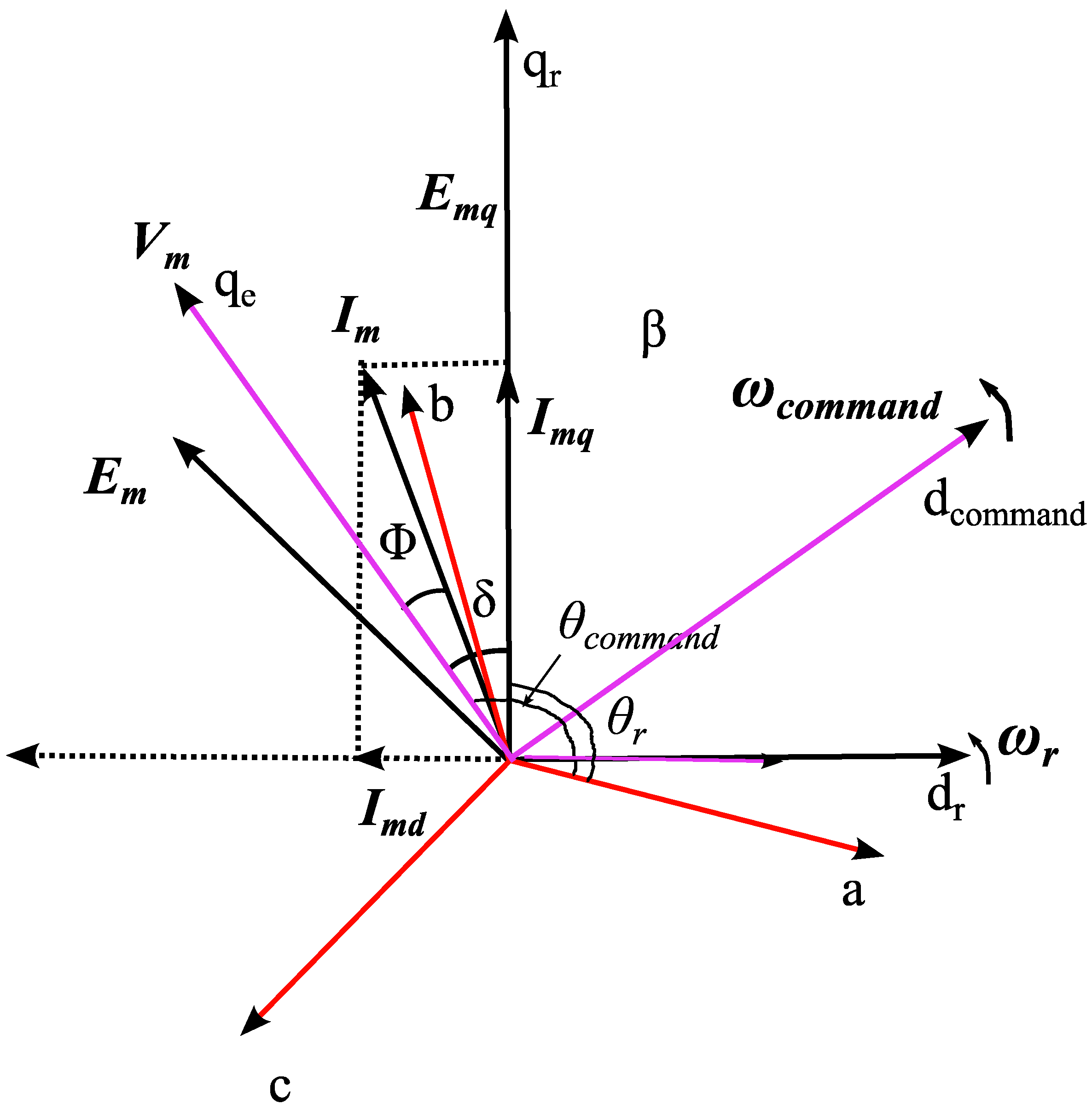
Appendix B
| Motor power | 90 (3ph) |
| Motor rated voltage | 3200 |
| Motor rated current | 17 |
| Base/Nominal frequency | 120 |
| Motor resistance | 3.5 |
| Motor (Q-axis) inductance | 55.2 |
| Motor (D-axis) inductance | 43.4 |
| Back EMF | 2900 |
| No. of poles | 4 |
| Moment of inertia J | 0.0275 |
| Viscous friction coefficient | 0.05 |
| Primary Voltage Side (V) | Secondary Voltage Side (V) | No Load Loss (W) | Load Loss (W) | % Impedance |
|---|---|---|---|---|
| 480 | 2200 | 650 | 3200 | 3.8 |
| 2600 | 3110 | 3.95 | ||
| 3000 | 3000 | 3.85 | ||
| 3400 | 2905 | 3.92 | ||
| 3700 | 2900 | 3.75 | ||
| 3900 | 2900 | 3.72 |
| Conductor size | #4 AWG |
| Inductance | 0.14 () |
| Capacitance | 80 () |
| Resistance | 0.3 () |
| Length of cable | 10000 () |
| Configuration | Delta-connection |
| Inductance | 40 () |
| Capacitance | 250 () |
| Resistance | 0.02 () |
| Cut-off frequency | 950 () |
References
- Singh, V.; Selvaraj, G.; Rajashekara, K. Enhanced Volts-per-Hertz Starting of Permanent Magnet Motor with Heavy Loads in Long Cable Subsea Applications. In Proceedings of the 2023 IEEE International Electric Machines and Drives Conference (IEMDC), San Francisco, CA, USA, 15–18 May 2023; pp. 1–7. [Google Scholar] [CrossRef]
- Permanent Magnet Motors for REDA ESP Pumps—Schlumberger. Available online: https://www.slb.com/-/media/files/al/product-sheet/permanent-magnet-motor-ps.ashx (accessed on 1 January 2022).
- PMM-PCP System—Borets. Available online: https://borets.com/wp-content/uploads/2021/01/BORETS-PMM-PCP-System.pdf (accessed on 28 July 2015).
- Baker Hughes. Magnefficient Permanent Magnet Motor. Available online: https://www.bakerhughes.com/production/artificial-lift/electrical-submersible-pump-systems/magnefficient-permanent-magnet-motor (accessed on 24 June 2020).
- Jahns, T.M.; Kliman, G.B.; Neumann, T.W. Interior permanent magnet synchronous motors for adjustable-speed drives. IEEE Trans. Ind. Appl. 1986, IA-22, 738–747. [Google Scholar] [CrossRef]
- Ogasawara, S.; Akagi, H. An approach to position sensorless drive for brushless DC motors. IEEE Trans. Ind. Appl. 1991, 27, 928–933. [Google Scholar] [CrossRef]
- Lee, W.-J.; Sul, S.-K. A new starting method of BLDC motors without position sensor. IEEE Trans. Ind. Appl. 2006, 42, 1532–1538. [Google Scholar] [CrossRef]
- Jang, G.H.; Park, J.H.; Chang, J.H. Position detection and start-up algorithm of a rotor in a sensorless BLDC motor utilizing inductance variation. IEEE Proc.-Electr. Power Appl. 2002, 149, 137–142. [Google Scholar] [CrossRef]
- Miki, I.; Inagaki, Y.; Nakashima, S. Sensorless initial rotor position estimation of surface permanent-magnet synchronous motor. IEEE Trans. Ind. Appl. 2000, 36, 1598–1603. [Google Scholar] [CrossRef]
- Tanaka, K.; Yuzawa, T.; Moriyama, R.; Miki, I. Initial rotor position estimation for surface permanent magnet synchronous motor. IEEE IAC 2001, 4, 2592–2597. [Google Scholar]
- Lai, Y.-S.; Shyu, F.-S.; Tseng, S.-S. New initial position detection technique for three-phase brushless DC motor without position and current sensors. IEEE Trans. Ind. Appl. 2003, 39, 485–491. [Google Scholar]
- Sugawara, J.; Kaimori, T.; Nishikata, S. A novel and simple initial rotor position detecting method for PMSMs. In Proceedings of the IEEE PEDS, Kuala Lumpur, Malaysia, 28 November–1 December 2005; pp. 612–617. [Google Scholar]
- Siemens. Medium Voltage Converters. 2016. Available online: http://www.industry.siemens.com/drives/global/en/converter/mv-drives/pages/default.aspx (accessed on 1 January 2021).
- TMEIC Corp. Medium Voltage AC Drives. 2013. Available online: https://www.tmeic.com/North%20America/259-Products%20MediumVoltageACDrives-116 (accessed on 1 January 2013).
- AMTECH. Medium Voltage Drives. 2013. Available online: http://www.amtechelectronics.com/product.aspx?sid=3 (accessed on 1 January 2013).
- Schneider Electric. Medium Voltage Variable Speed Drive. 2016. Available online: http://www.schneider-electric.com/en/productrange/61394-altivar-1200 (accessed on 1 January 2016).
- Toshiba. Medium Voltage Drives. 2016. Available online: https://www.toshiba.com/tic/industrial-systems/adjustable-speeddrives/mediumvoltage-drives/ (accessed on 1 January 2016).
- Ingeteam. Frequency Converters. Available online: http://www.ingeteam.com/Portals/0/Catalogo/Sector/Documento/SSE_258_Archivo_sbp15-catalogo-ingedrive.pdf (accessed on 14 October 2023).
- Yaskawa. Medium Voltage Drives. 2016. Available online: https://www.yaskawa.com/pycprd/products/mv-drives (accessed on 22 March 2016).
- Aijun, C.; Xinhai, J. A stable V/HZ control method for permanent magnet synchronous motor drives. In Proceedings of the IEEE Transportation Electrification Conference and Expo, Asia-Pacific (ITEC Asia-Pacific), Harbin, China, 7–10 August 2017; pp. 1–5. [Google Scholar]
- Wang, Z.; Lu, K.; Blaabjerg, F. A Simple Startup Strategy Based on Current Regulation for Back-EMF-Based Sensorless Control of PMSM. IEEE Trans. Power Electron. 2012, 27, 3817–3825. [Google Scholar] [CrossRef]
- Soni, U.K.; Tripathi, R.K. Sensorless control of high-speed BLDC motor using equal area criterion based precise commutation scheme with Fuzzy based phase delay compensation. Int. Trans. Electr. Energy Syst. 2021, 31, e13001. [Google Scholar] [CrossRef]
- Chen, Y.; Yang, T.; Fan, L.; Bozhko, S. Sensorless Control Design of High-Speed Electric Drives in Discrete-Time Domain for Mild-Hybrid Turboprop Aircraft Applications. IEEE Trans. Transp. Electrification 2022, 9, 3601–3619. [Google Scholar] [CrossRef]
- Cheng, K.-Y. Initial Rotor Position Detection for Permanent Magnet Synchronous Motors. U.S. Patent Application 12/689,411, 22 July 2010. [Google Scholar]
- Tursini, M.; Petrella, R.; Parasiliti, F. Initial rotor position estimation method for PM motors. IEEE Trans. Ind. Appl. 2003, 39, 1630–1640. [Google Scholar] [CrossRef]
- Bist, V.; Wekhande, S. Accurate Startup Techniques in a Sensorless Field-Oriented Control BLDC (Sinusoidal) Motor; Allergo Microsystems: Manchester, NH, USA, 2022. [Google Scholar]
- Chang, Y.-C.; Tzou, Y.-Y. A New Sensorless Starting Method for Brushless DC Motors without Reversing Rotation. In Proceedings of the 2007 IEEE Power Electronics Specialists Conference, Orlando, FL, USA, 17–21 June 2007; pp. 619–624. [Google Scholar] [CrossRef]
- Acarnley, P.; Watson, J. Review of position-sensorless operation of brushless permanent-magnet machines. IEEE Trans. Ind. Electron. 2006, 53, 352–362. [Google Scholar] [CrossRef]
- Janislav, S.E.G.A. Low to High Speed Operation of a Sensorless Brushless DC Motor. U.S. Patent 11,264,930, 1 March 2022. [Google Scholar]
- Perera, P.D.C.; Blaabjerg, F.; Pedersen, J.K.; Thogersen, P. A sensorless, stable V/f control method for permanent-magnet synchronous motor drives. IEEE Trans. Ind. Appl. 2003, 39, 783–791. [Google Scholar] [CrossRef]
- Ancuti, R.; Boldea, I.; Andreescu, G.-D. Sensorless V/f control of high-speed surface permanent magnet synchronous motor drives with two novel stabilising loops for fast dynamics and robustness. IET Electr. Power Appl. 2010, 4, 149–157. [Google Scholar] [CrossRef]
- Consoli, A.; Scelba, G.; Scarcella, G.; Cacciato, M. An effective energy-saving scalar control for industrial IPMSM drives. IEEE Trans. Ind. Electron. 2013, 60, 3658–3669. [Google Scholar] [CrossRef]
- Nair, S.V.; Hatua, K.; Prasad, N.V.P.R.D.; Reddy, D.K. A quick I-f starting of PMSM drive with pole slipping prevention and reduced speed oscillations. IEEE Trans. Ind. Electron. 2021, 68, 6650–6661. [Google Scholar] [CrossRef]
- Liu, J.; Dai, J.; Royak, S.; Schmidt, P.B.; Al-Nabi, E.; Nondahl, T.A. Design and Implementation of Position Sensorless Starting Control in Industrial Drives with Output Filter and Transformer for Oil/Pump Applications. IEEE Trans. Ind. Appl. 2019, 55, 471–479. [Google Scholar] [CrossRef]
- Liu, J.; Nondahl, T.A.; Dai, J.; Royak, S.; Schmidt, P.B. A Seamless Transition Scheme of Position Sensorless Control in Industrial Permanent Magnet Motor Drives with Output Filter and Transformer for Oil Pump Applications. IEEE Trans. Ind. Appl. 2020, 56, 2180–2189. [Google Scholar] [CrossRef]
- Selvaraj, G.; Duan, Y.; Liu, Y.; Rayner, M. Voltage Optimization Technique for a Permanent Magnet Motor used in an Electric Submersible Pump. U.S. Patent US 20200321824A1, 3 April 2020. [Google Scholar]
- Stellas, D.; Hansen, M.T.; Thiringer, T.; Stromsvik, T.; Ulvestad, H.B. Position-sensorless control of a submersible PMSM fed over a long cable and two transformers. In Proceedings of the European Conference on Power Electronics and Applications, Lappeenranta, Finland, 26–28 August 2014; pp. 1–10. [Google Scholar]
- Wilson, D.; Robinson, P.; Conrad, D.; Heideck, K. Deployment of MV drives in electrical submersible pumps in steam assist gravity drainage applications. In Proceedings of the Petroleum and Chemical Industry Technical Conference (PCIC), Calgary, AB, Canada, 18–20 September 2017; pp. 397–404. [Google Scholar]
- Singh, V.; Majumder, M.G.; Rajashekara, K.; Reddy, S.R.P. Parameter estimation for sensorless position control of PMSM drives with long cables in subsea applications. IEEJ J. Ind. Appl. 2023, 12, 303–311. [Google Scholar] [CrossRef]
- ABB. Low Voltage Drives. Available online: https://cdn2.hubspot.net/hubfs/1792768/PDF/abb-low-voltage-drives-product-guide.pdf (accessed on 1 January 2015).
- Siemens. Low Voltage Drives. Available online: https://assets.new.siemens.com/siemens/assets/api/uuid:01b48121-ad1a-4059-ade1-75c5fac219eb/SINAMICS-LV-Drives-Family-Brochure.pdf (accessed on 1 January 2020).
- TMEIC Corp. Low Voltage AC Drives. Available online: https://www.tmeic.com/products/tmdrive-10e2-dp (accessed on 6 January 2021).
- AMTECH. Low Voltage Drives. Available online: https://www.amtechdrives.com/product_pdf/axperteazyplus_brochure.pdf (accessed on 21 December 2022).
- ALSTOM. Low Voltage Drives: Intelligent Drive Technology. Available online: http://alsintec.com/documents/alstom/drives/Alspa%20MV1000.pdf (accessed on 4 March 2010).
- Schneider Electric. Low Voltage Variable Speed Drive. Available online: https://www.se.com/us/en/product-range/64501-altivar-process-680-afe-low-harmonic-drive/?parent-subcategory-id=86129#documents (accessed on 17 October 2023).
- Fuji Electric Europe. Low Voltage Variable Speed Drive. Available online: https://www.fujielectric.com/products/ac_drives_lv/north-america/ (accessed on 1 September 2017).
- Delta Electronics. Low Voltage Drive. Available online: https://filecenter.deltaww.com/Products/download/06/060101/Manual/DELTA_IA-MDS_CFP2000_UM_EN_20210325.pdf (accessed on 31 March 2020).
- Eaton. Low Voltage Adjustable Frequency Drives. Available online: https://www.eaton.com/content/dam/eaton/products/industrialcontrols-drives-automation-sensors/en-globalprime/eaton-drives-ecodesign-drives-mz040046-en-us.pdf (accessed on 1 March 2022).
- Toshiba. Low Voltage Drives. Available online: https://www.toshiba.com/tic/motors-drives/low-voltage-adjustable-speed-drives/lv-industrial-drives/as3 (accessed on 1 April 2022).
- WEG Group. Low Voltage Variable Speed Drive. Available online: https://www.weg.net/catalog/weg/US/en/Drives/Variable-Speed-Drives/System-Drives/CFW11-Pump-Genius/DRIVE-CFW110370T4SZ-PGM/p/14396171 (accessed on 3 November 2023).
- Hitachi. Medium Voltage Drives. Available online: https://www.hitachi-hirel.com/products/drives/low-voltage-drives/wj200-series-low-voltage-drive (accessed on 1 January 2023).
- Ingeteam. Low Voltage Frequency Converters. Available online: https://www.ingeteam.com/en-us/power-electronics/power-converters/pc28_6_488/ingedrive-lv800.aspx (accessed on 4 March 2010).
- Rockwell Automation. Low Voltage AC Drives. Available online: https://configurator.rockwellautomation.com/configurator/3C11204E8B2A4F2D8BBFFF57479C4B21/summary (accessed on 1 September 2020).
- Yaskawa. Low Voltage Drives. Available online: https://www.yaskawa.com/delegate/getAttachment?documentId=SIEPC71061737&cmd=documents&openNewTab=true&documentName=SIEPC71061737.pdf (accessed on 1 December 2022).
- Singh, V.; Majumder, M.G.; Rajashekara, K.; Siddavatam, R.P.R. Parameter estimation for sensorless position control of PMSM drives with long cable in subsea applications. In Proceedings of the International Power Electronics Conference (IPEC-Himeji 2022- ECCE Asia), Himeji, Japan, 15–19 May 2022; pp. 384–388. [Google Scholar]
- ABB Low Voltage Industrial Drive “All-Compatible ACS880 Single Drives”. Available online: https://new.abb.com/drives/low-voltage-ac/industrial-drives/acs880-single-drives (accessed on 22 March 2023).
- GE Power Conversion LV8 Platform “High Performance for Modular Drive for Industrial Applications”. Available online: https://www.gepowerconversion.com/sites/default/files/2022-01/GEA34852_LV8Platform_FS_High%20performance%20modular%20drive_EN_20220126_Rev2.pdf (accessed on 1 January 2022).
- Schaffner. LC Sine Wave Filter for Motor Drives. 2022. Available online: https://docs.rs-online.com/3b90/0900766b81539b2f.pdf (accessed on 4 March 2010).
- MSD, “Sine Wave Filter”. Available online: https://vfds.com/content/manuals/tci/MSD-Brochure.pdf (accessed on 1 January 2019).
- MTE Corporation. “Sinewave Filter Series A 200-600 VAC”, User Manual. Available online: https://www.mtecorp.com/wp-content/uploads/INSTR-020.pdf (accessed on 9 March 2009).
- TDK. EMC Filter 3-Line Filters Sine-Wave Output Filters 300/520 V AC, 4 A … 390 A, 40 °C. Available online: https://www.tdk-electronics.tdk.com/inf/30/db/emc_2014/B84143V_R_S229.pdf (accessed on 1 January 2021).
- Eaton. “Three-Phase Pad-Mounted Compartmental Type Transformer”. July 2015. Available online: https://www.eaton.com/content/dam/eaton/products/utility-and-grid-solutions/transformer/pad-mounted-transformer/Eaton-Pad-mounted-Transformer-Brochure-EN-US.pdf (accessed on 12 July 2015).
- Jefferson. Available online: https://jeffersonelectric.com/wp-content/uploads/LIT901_0117-Jefferson-Full-Catalog.pdf (accessed on 6 July 2023).
- Siemens. “Low Voltage Transformers with DOE 2016 Updates”, Series H and Series J Addendums. Available online: https://assets.new.siemens.com/siemens/assets/api/uuid:54e8601e-d006-4493-90dc-c0a918de491d/sie-ca-transformer-speedfax-supplement.pdf (accessed on 1 January 2016).
- Schnider. Medium Voltage Transformers Specification Guide. Available online: https://stevenengineering.com/wp-content/uploads/2019/02/45TMEDVOLT.pdf (accessed on 1 January 2019).
- REX POWER MAGNETICS, “DRY Type Transformer”. Available online: https://www.pccweb.com/wp-content/uploads/2021/01/Rex-Power-Magnetics-Catalog.pdf (accessed on 14 October 2020).
- ABB. Low Voltage Dry Type Transformers 600V Class Large Power. Available online: https://electrification.us.abb.com/catalog/buylog/10A_BuyLog_LVDryTypeTransformers.pdf (accessed on 1 January 2023).


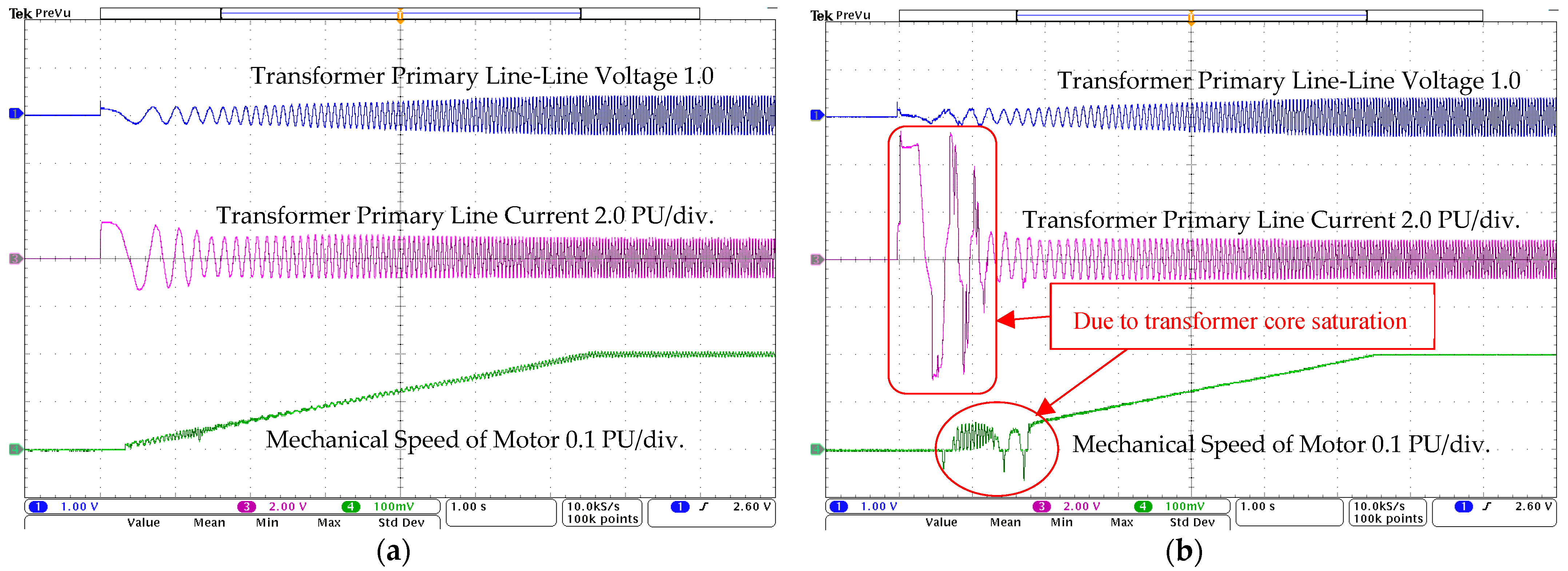

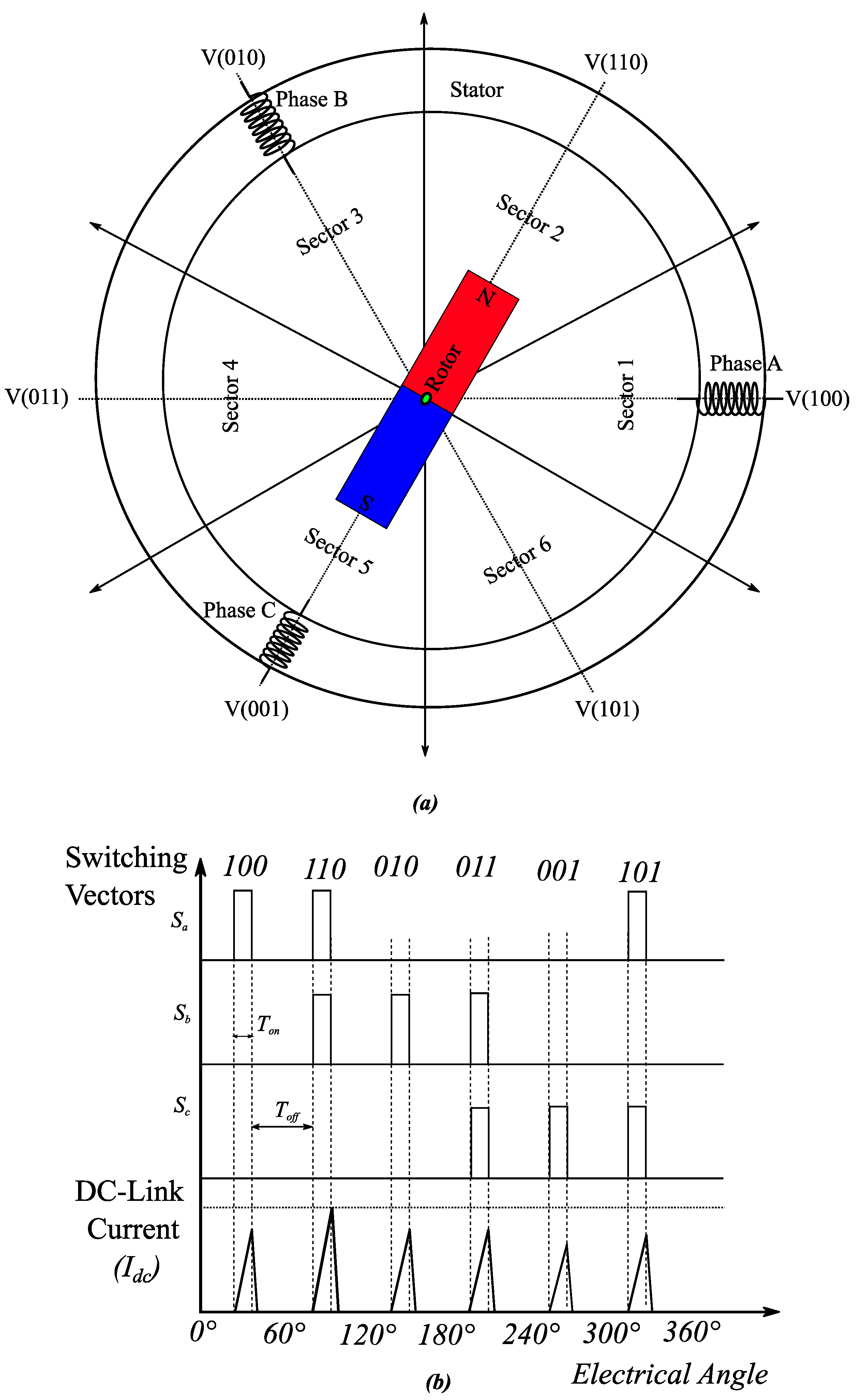


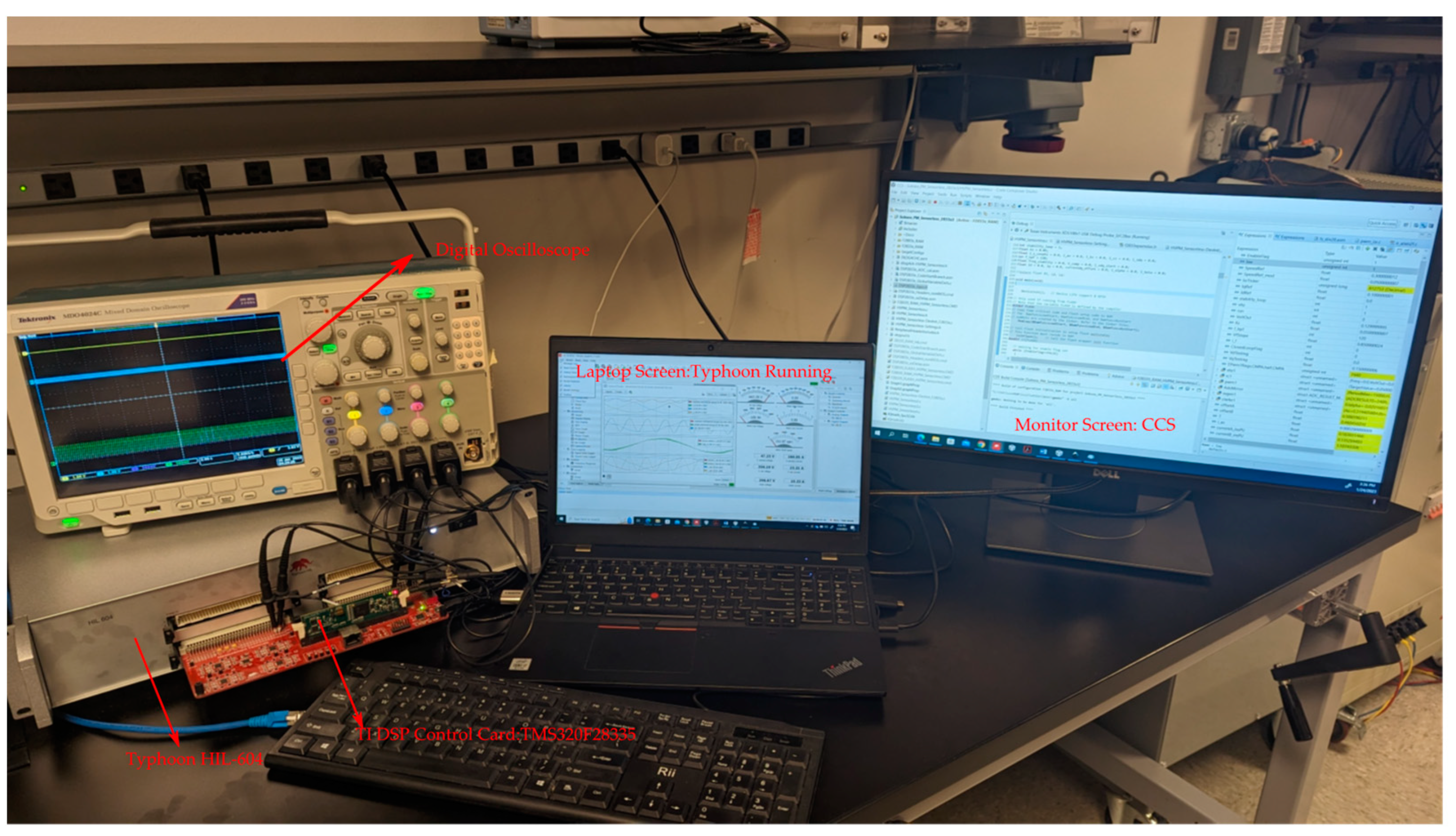
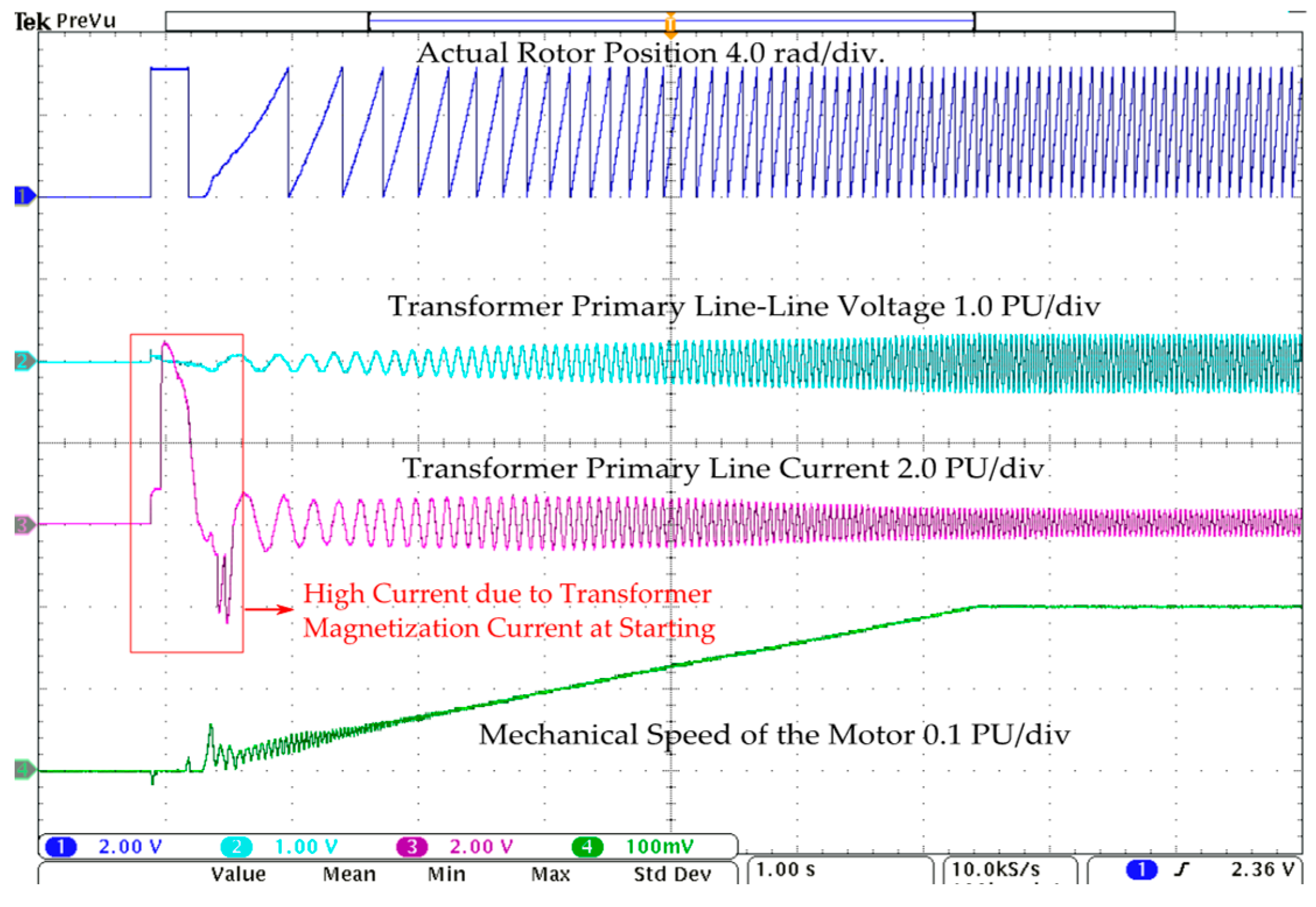
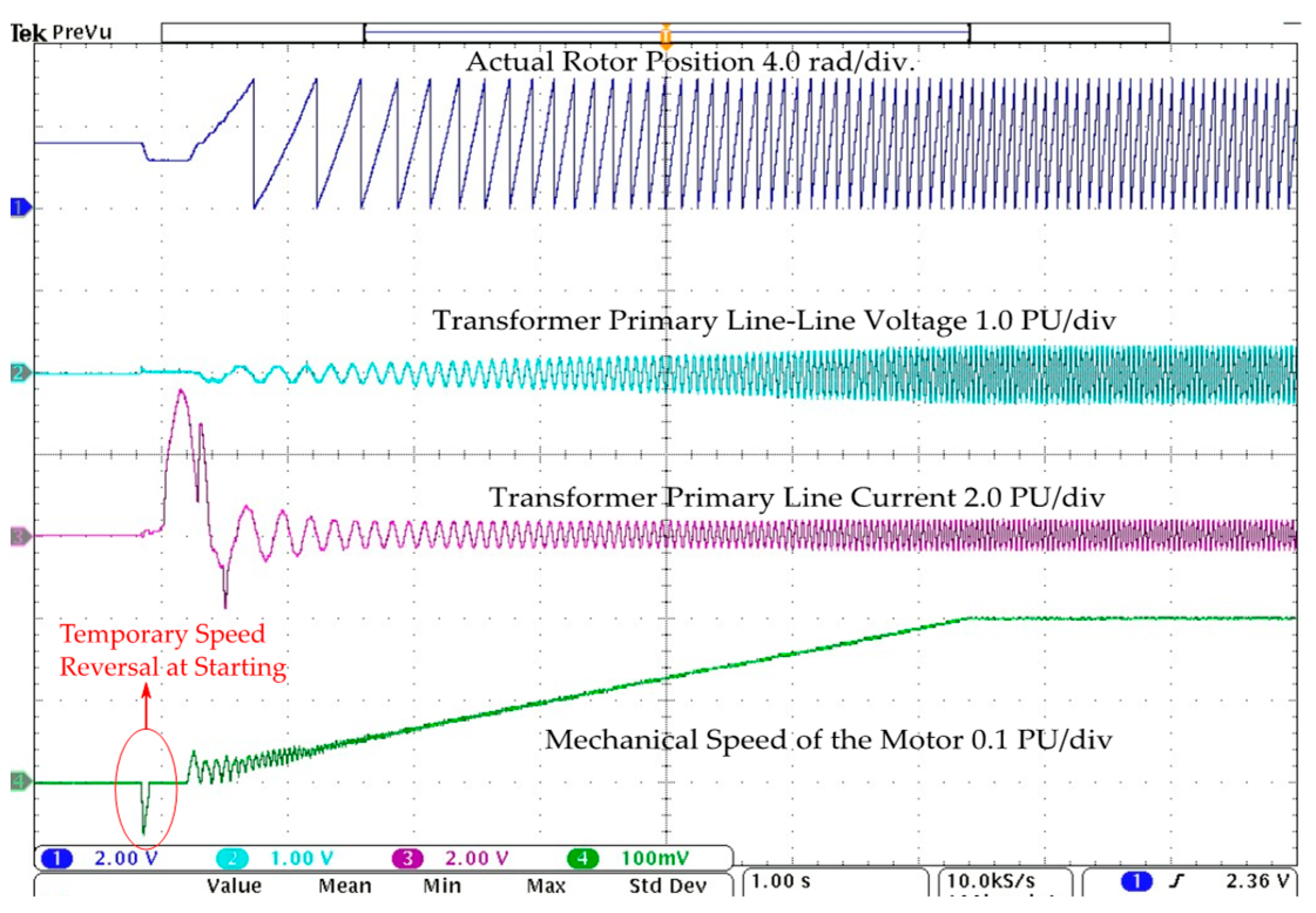
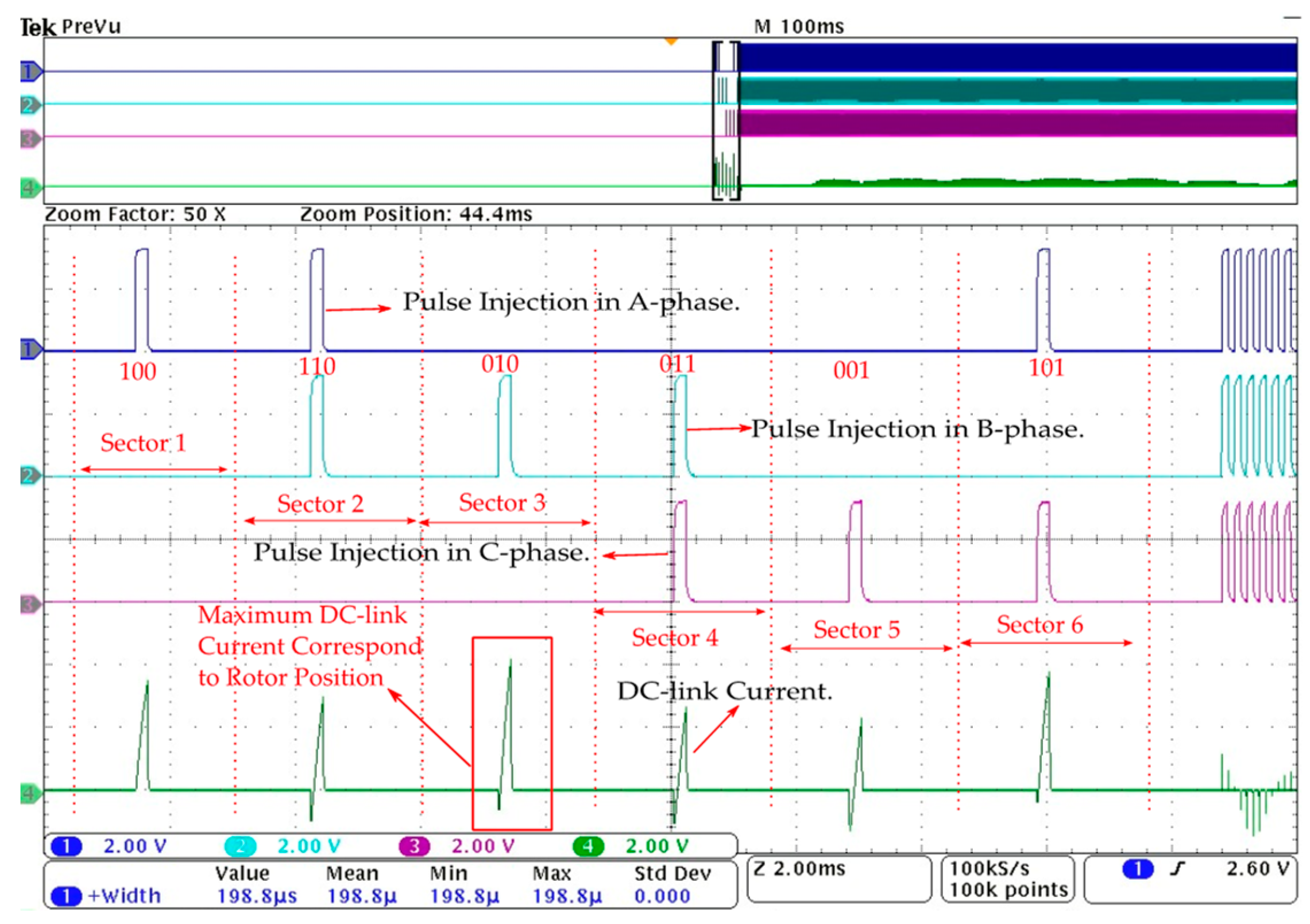

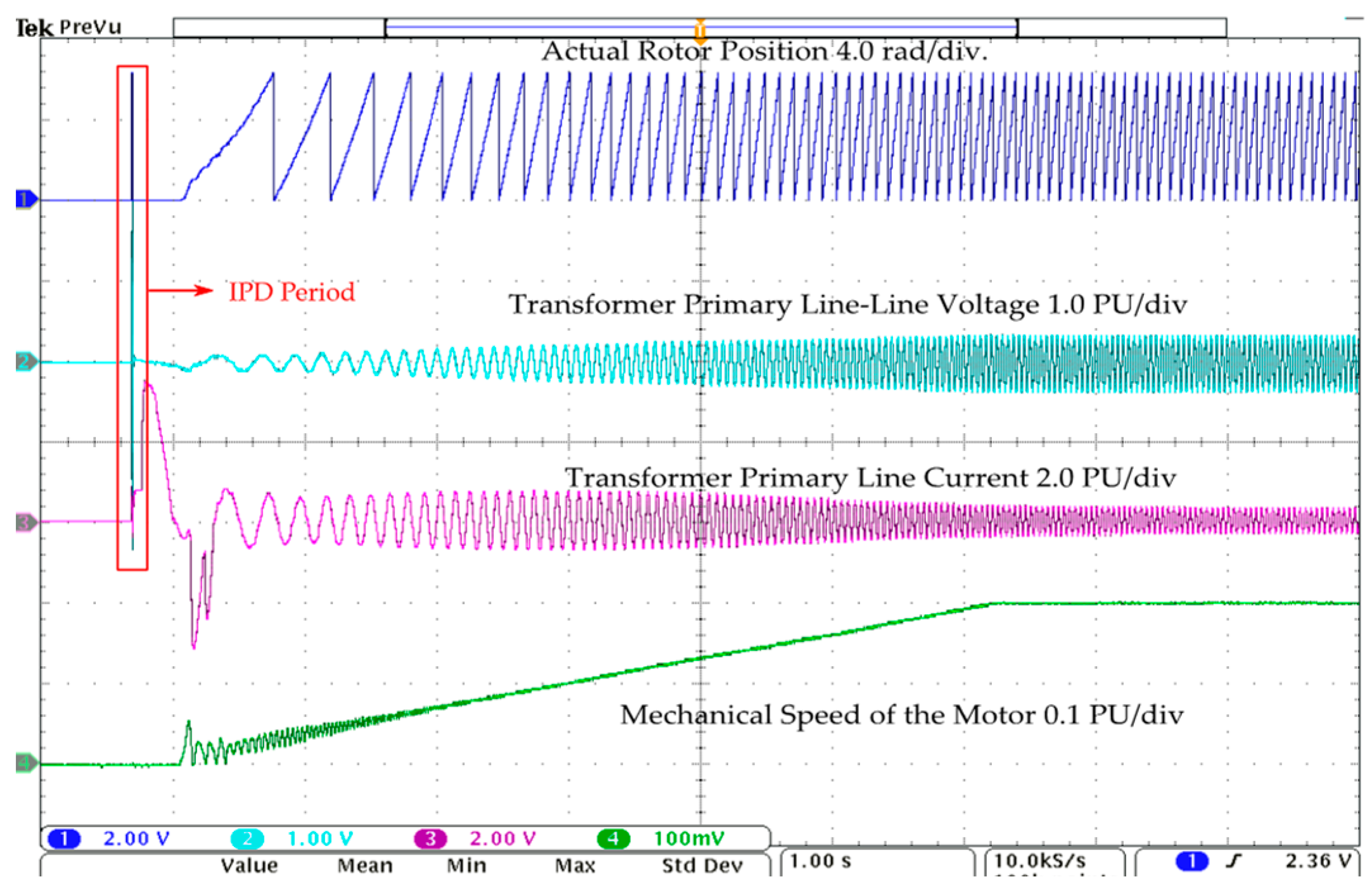
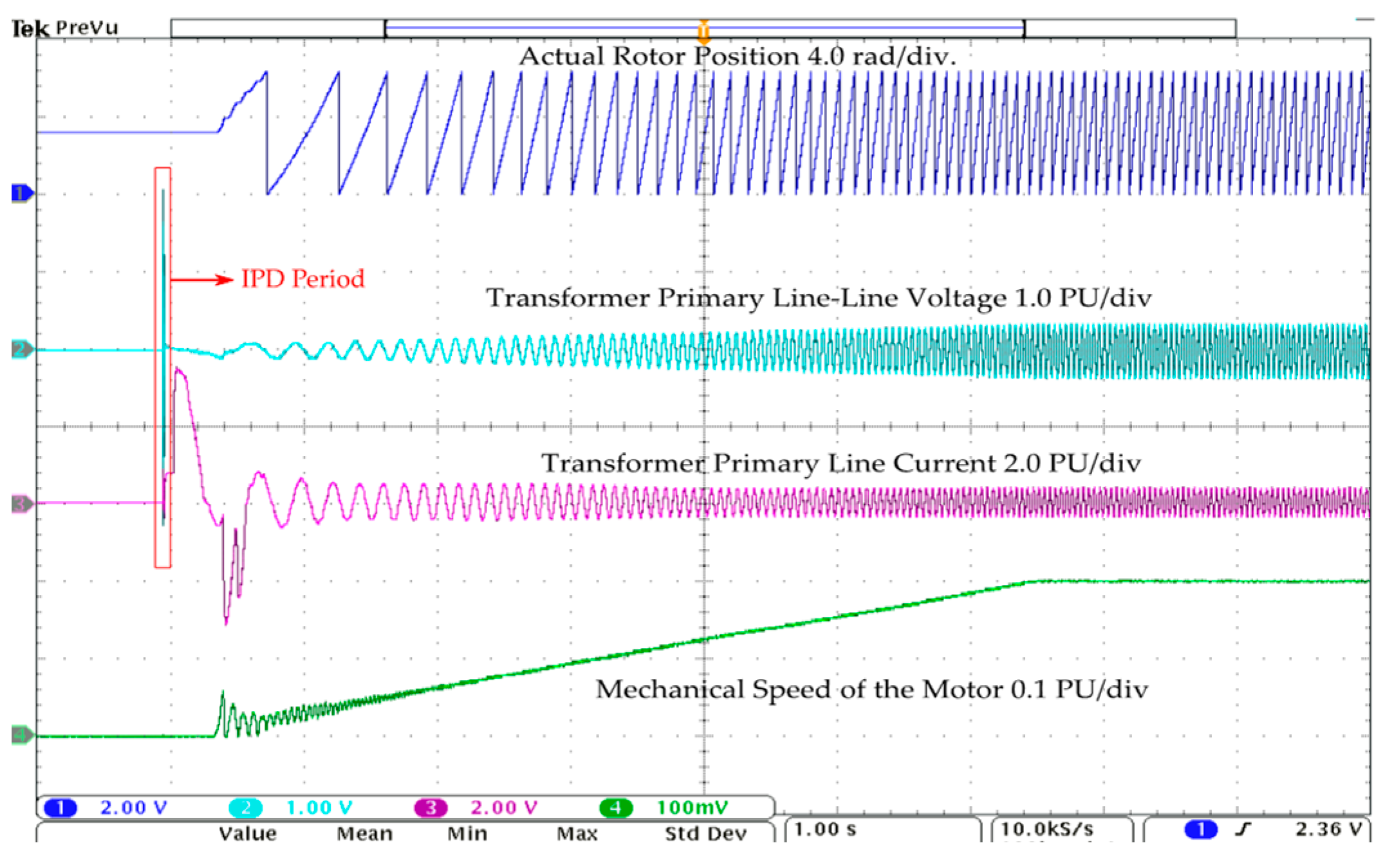
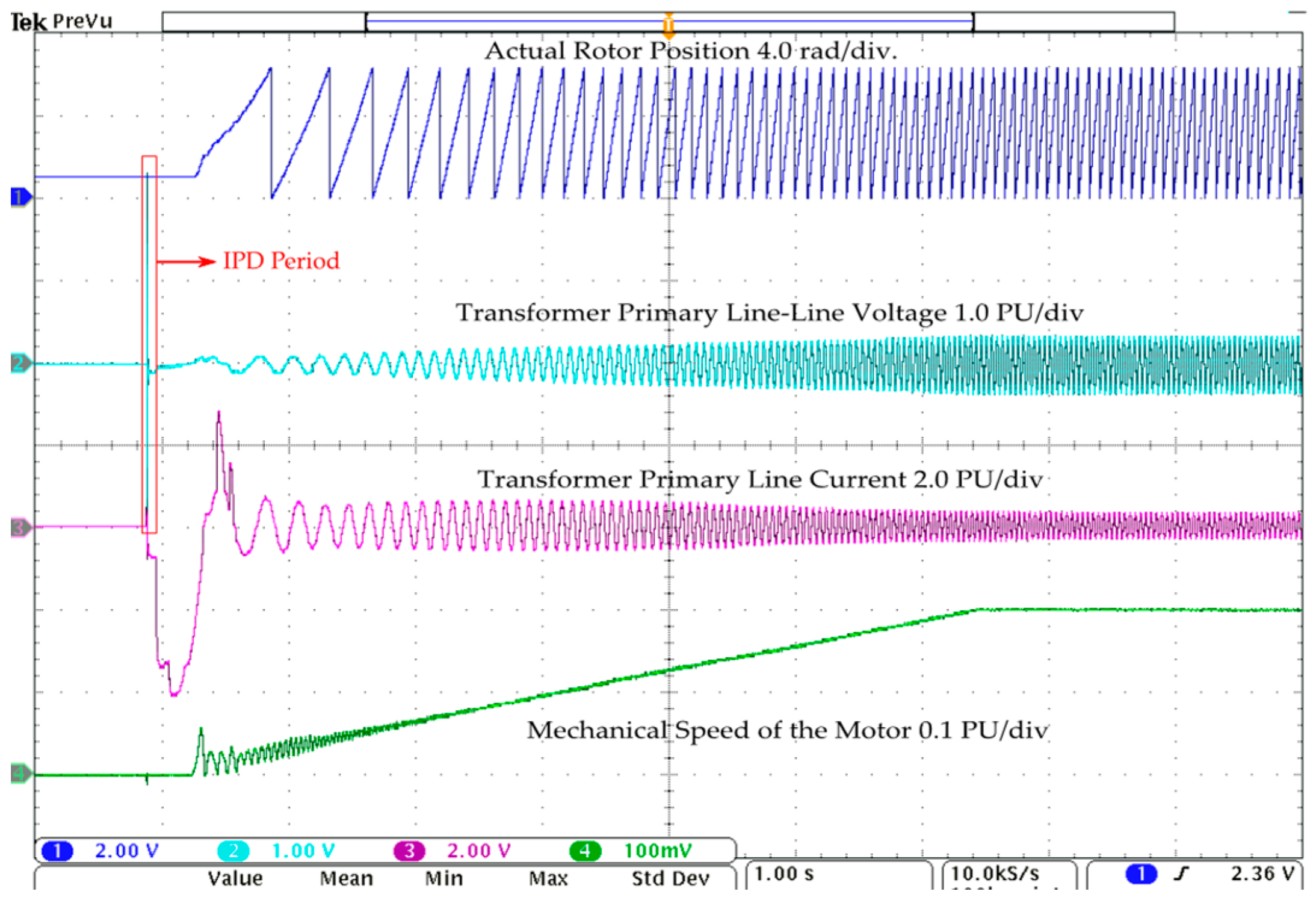
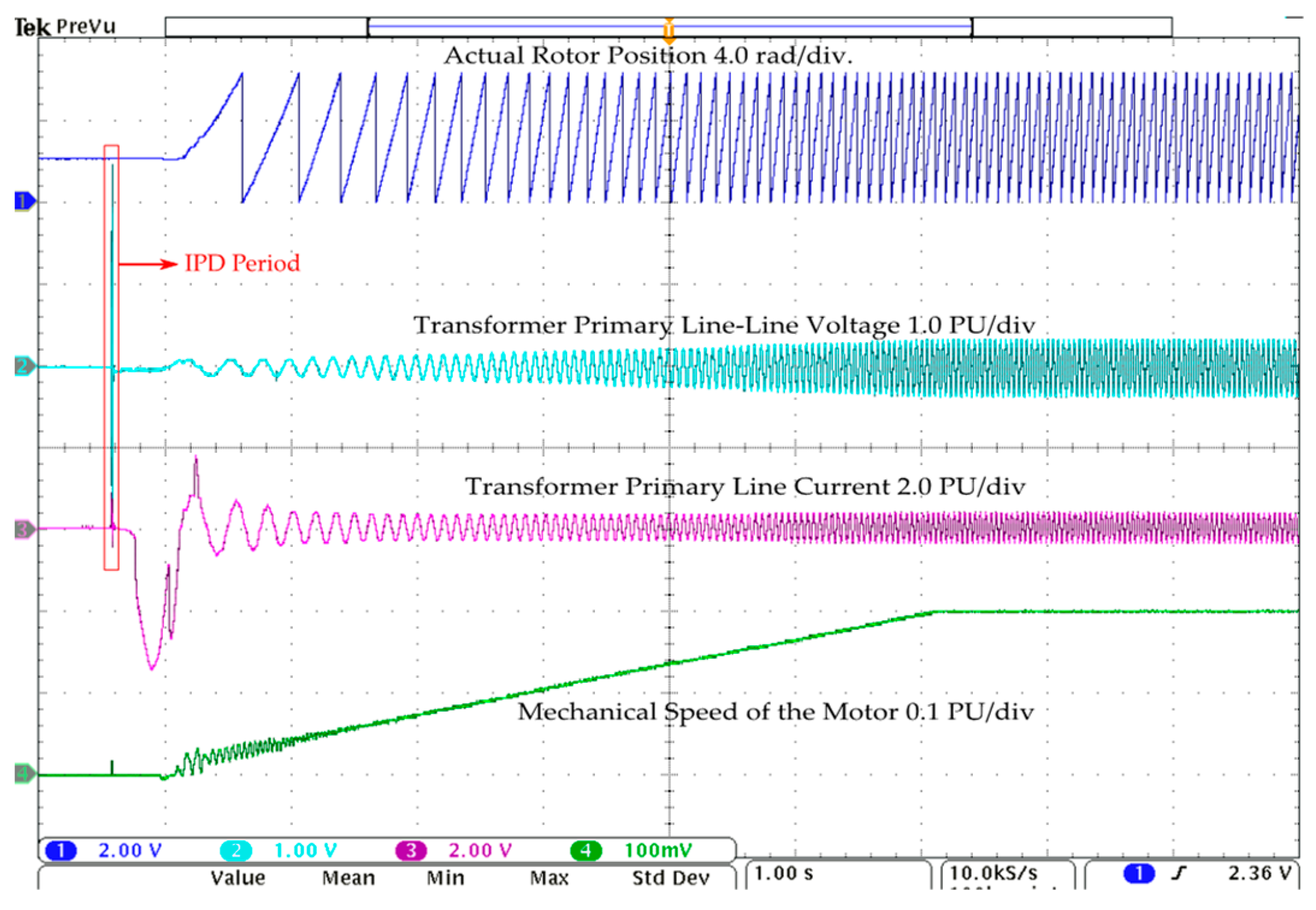
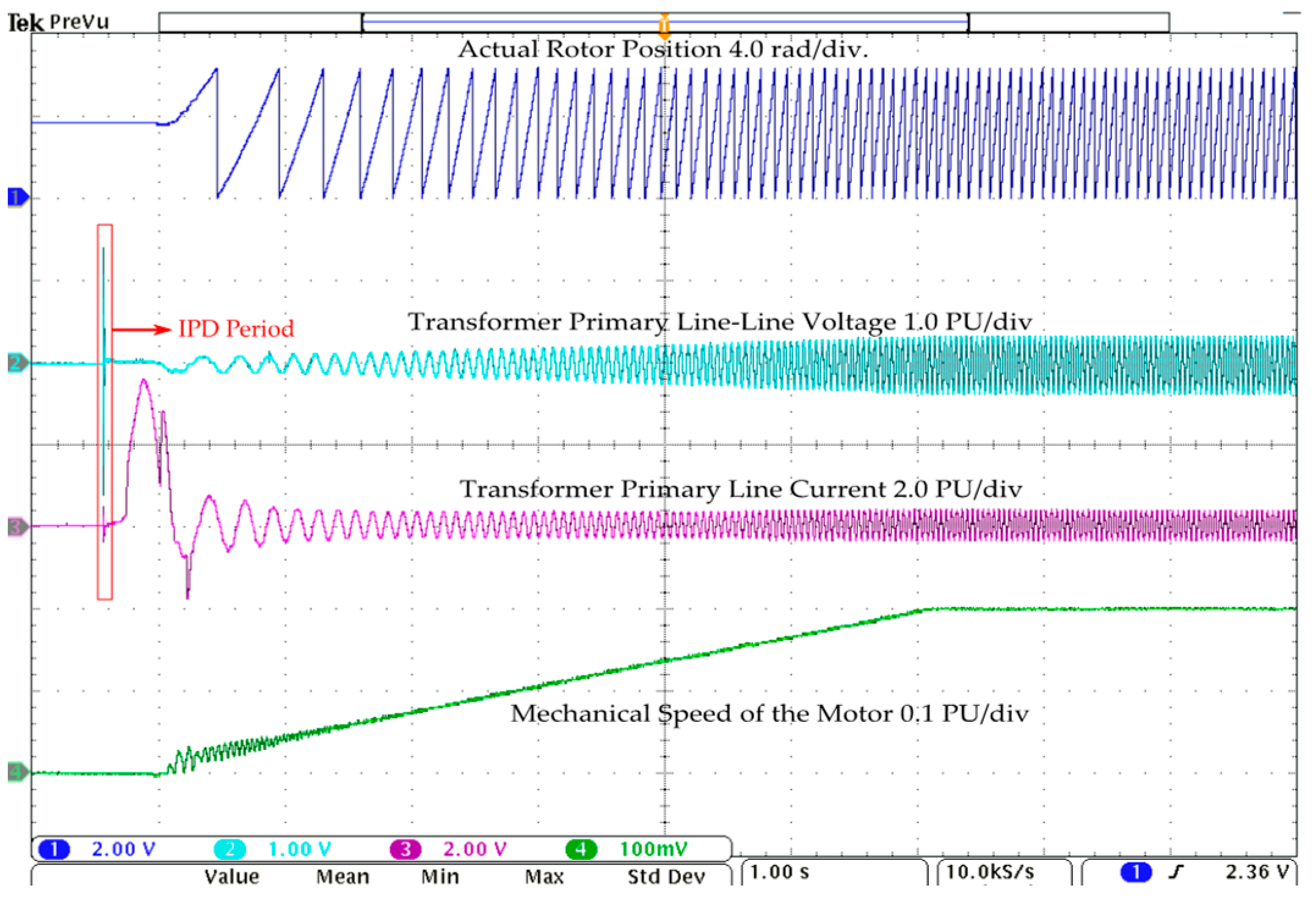
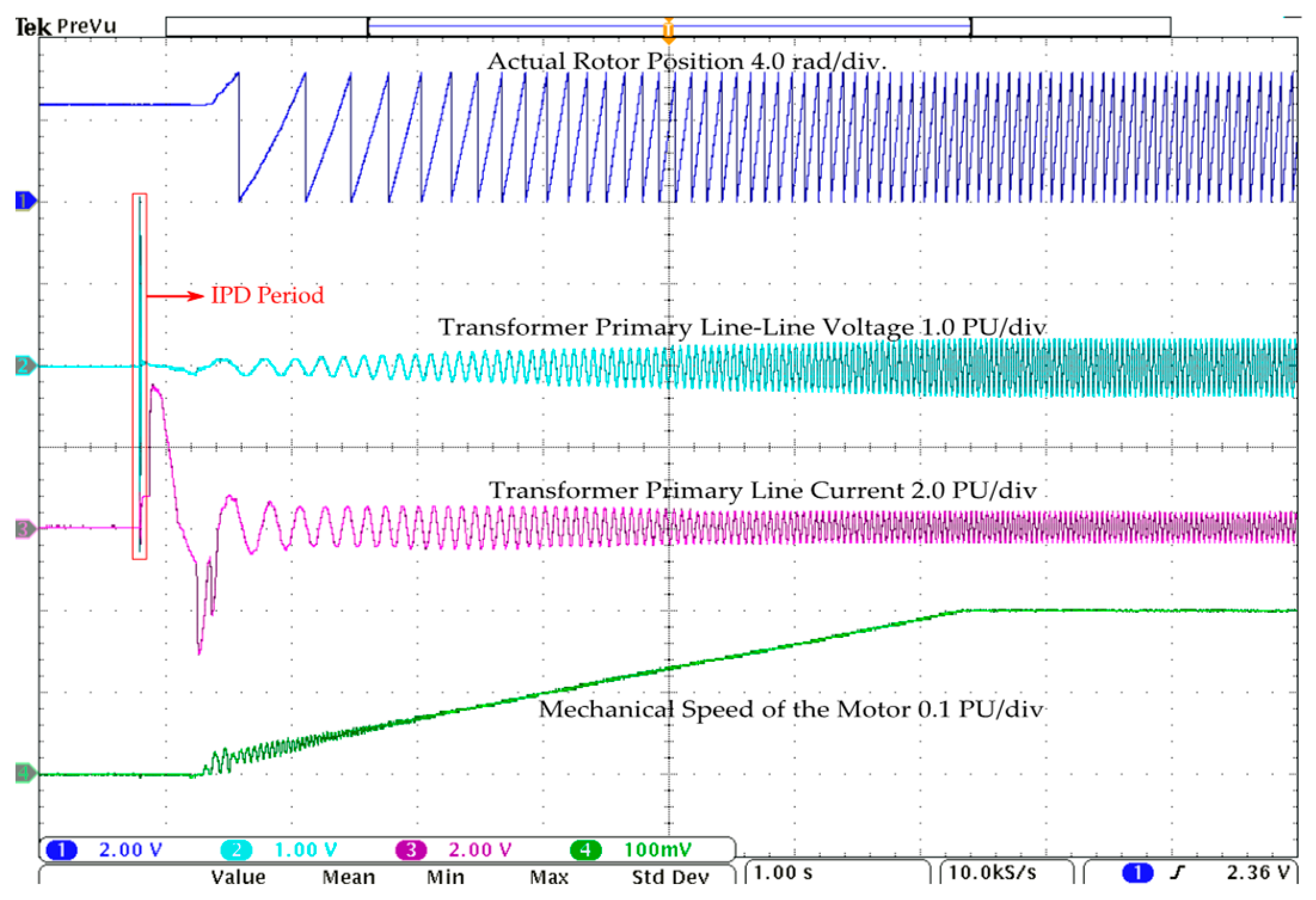
Disclaimer/Publisher’s Note: The statements, opinions and data contained in all publications are solely those of the individual author(s) and contributor(s) and not of MDPI and/or the editor(s). MDPI and/or the editor(s) disclaim responsibility for any injury to people or property resulting from any ideas, methods, instructions or products referred to in the content. |
© 2024 by the authors. Licensee MDPI, Basel, Switzerland. This article is an open access article distributed under the terms and conditions of the Creative Commons Attribution (CC BY) license (https://creativecommons.org/licenses/by/4.0/).
Share and Cite
Singh, V.; Selvaraj, G.; Rajashekara, K. Enhanced Volts-per-Hertz Sensorless Starting of Permanent Magnet Motor with Heavy Loads in Long-Cable Subsea Applications. Energies 2024, 17, 957. https://doi.org/10.3390/en17040957
Singh V, Selvaraj G, Rajashekara K. Enhanced Volts-per-Hertz Sensorless Starting of Permanent Magnet Motor with Heavy Loads in Long-Cable Subsea Applications. Energies. 2024; 17(4):957. https://doi.org/10.3390/en17040957
Chicago/Turabian StyleSingh, Virendra, Goutham Selvaraj, and Kaushik Rajashekara. 2024. "Enhanced Volts-per-Hertz Sensorless Starting of Permanent Magnet Motor with Heavy Loads in Long-Cable Subsea Applications" Energies 17, no. 4: 957. https://doi.org/10.3390/en17040957
APA StyleSingh, V., Selvaraj, G., & Rajashekara, K. (2024). Enhanced Volts-per-Hertz Sensorless Starting of Permanent Magnet Motor with Heavy Loads in Long-Cable Subsea Applications. Energies, 17(4), 957. https://doi.org/10.3390/en17040957







